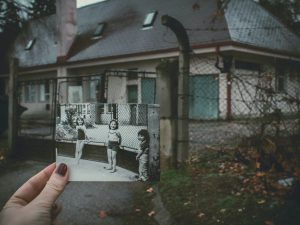Freeing Yourself From Childhood Trauma
 Most of us have experienced some form of trauma in our development. We may have endured what mental health professionals refer to as a “big T Trauma” like abuse, serious loss, or a life-threatening experience, or we may have examples of “little t trauma” from events that weren’t life-threatening but caused emotional distress and altered our way of seeing ourselves, other people, and the world.
Most of us have experienced some form of trauma in our development. We may have endured what mental health professionals refer to as a “big T Trauma” like abuse, serious loss, or a life-threatening experience, or we may have examples of “little t trauma” from events that weren’t life-threatening but caused emotional distress and altered our way of seeing ourselves, other people, and the world.
Childhood trauma of any kind can affect our relationships with others as well as our mental and physical health. No matter when a trauma occurred or what shape it took, the importance of making sense of the experience cannot be overstated.
The reason for this is that unresolved trauma haunts us in ways resolved trauma does not. Research shows that when we fail to process both large and small traumas, we can become stuck in our pain. Our trauma can impact our lives in all kinds of ways we don’t expect. It can cause us to feel alarmed and triggered in moments for reasons we don’t understand.
Trauma is unresolved when we did not get to process it either at the time it occurred or shortly after. Thus, there is a great deal of good that can come from taking a deep dive into our own story. So, how can we take steps to surface our memories and understand our trauma? Here are nine things I recommend when helping people to create a coherent narrative around their experience.
1. Look for overreactions.
We can start by looking for places where we have strong or intense reactions. The feelings around old trauma can be triggered by anything from our partner’s tone to a baby’s cry. Any time we’re experiencing a heightened emotional reaction that doesn’t quite fit the moment, it’s worth exploring if there may be underlying, unresolved trauma impacting us.
Interpersonal neurobiologist Dr. Daniel Siegel uses the acronym SIFT to describe a method for gaining insight into our internal state. First, we can look for any Sensations we may be feeling, perhaps, our heart racing or our forehead getting warm. Next, we can explore the Images that come to mind. This could be anything from a stern look on someone’s face to a certain wallpaper in a room. We can then turn our attention to any Feelings that arise, such as panic, sadness, shame, or anger. Last, we can take note of any Thoughts that spring up, i.e. “You should get out of here. You’re not safe in this situation.”
The sensations, images, feelings, and thoughts that are being stirred may have more to do with the past then our present. As a result, they offer clues into events or circumstances that may have been traumatic to us at a time when we weren’t fully able to process the experience.
2. Quickly, write down 10 traumas you’ve experienced in childhood.
Many people who I ask to try this exercise start off by saying, “I don’t think I can think of 10 traumas that have occurred in my early life.” Others have felt able to go on with a much longer list. Yet, setting a goal of starting with 10 usually encourages us to stretch our minds and memories and reach into experiences and events that we may not first label as trauma. Again, these can be big T or little t events.
Very often, we try to bury or gloss over bad things that happened to us, especially when those things were frightening or occurred when we were too young to fully understand them. We may never have told our own story around these events, so we don’t often hold them in our conscious mind. As uncomfortable as it can be at first, it really helps to start identifying the events that affected us. Very often, even the things that had a strong influence on us get overlooked or forgotten. Bringing them to light is a first step to making sense of our story.
3. Think it through.
As we write down specific events, it’s very likely that certain parts of the story won’t quite make sense to us. We may realize different aspects of our experience are unresolved or have vanished from our mind. We may notice a jumbled timeline or gaps in our memory. Or, we may rethink a part of our story that we always thought of one way but now view completely differently. For example, many people I’ve talked to attributed a lot of blame to themselves as children. For example, one woman even grew up believing she’d killed her dog, because he’d been hit by a car after she’d accidentally left the back door of her house open. As we explore our own memory, it’s beneficial to find those places where the story is not coherent and could use more reflection.
4. Calm down using the RAIN approach.
Investigating our emotions and memories can shake us up. When something painful or distressing arises, psychologists Jack Kornfield and Tara Brach recommend the RAIN Approach, which involves these four steps:
- Recognize the trauma or loss. Pause and notice what you’re feeling.
- Acknowledge/ Accept/ Allow whatever strong emotion is occurring in the present. We can accept the truth that this trauma occurred and may not be resolved.
- Investigate the experience as it relates to your past and present life.
- Non-identification with the experience, which means don’t over-identify with what happened or allow it to define you. Remember that the memory is not happening to you now and does not determine who you are.
5. Gather information.
Sometimes, if there are gaps in our memory, it’s helpful to ask others to share their perspective. Family members and friends who were present around the time of our trauma may be helpful in giving us a fuller understanding of the experience. There may be a chance that the person will disagree with or negate our experience, especially if they have their own confusion around an event. In these cases, it’s important to remember that it’s still what the experience meant to us that matters. If something feels true to us, it’s okay to accept that that is our experience or personal truth that affected our life. Still, the input from someone we trust can help us piece together things we don’t remember or have doubts around.
6. Feel the full pain of what happened.
When we bring our story to light, it’s sure to stir some deep emotions. It doesn’t have to make sense why something feels so painful. It just is what it is. Don’t try to rationalize away the feelings, but rather, accept that they are real and that they matter. Allowing ourselves to feel the feeling fully without judgment or an attempt to stop ourselves is an important step in processing and resolving the original trauma. This will enable us to gain relief. Remember, our feelings can be like a wave, rising and falling, eventually returning us to a state of calm, but only when we allow its full cycle to unravel.
7. Write it down.
As we bring our stories to the surface, we can keep putting them to paper. In many cases, it helps tremendously just to write about these things. Any feelings, thoughts, and memories are acceptable. We should meet the details of our story with self-compassion, patience, and without judgement. It can even help to write what we think may have happened based on our current day reactions. Often, when people start to do this the memories rise to the surface.
8. Tell someone your story.
Pick someone you trust and tell them the story of your trauma. Often, others can see the situation more clearly than we can and, therefore, provide perspective and insight. Those close to us will often have a kinder attitude toward us and more compassion than we have for ourselves. This can aid us in making sense of what happened and change our feeling toward ourselves. It can help us begin to challenge any long-held negative beliefs about ourselves that stemmed from the traumatic event.
9. Create a coherent narrative.
When we’ve started to identify the traumas that occurred, we can ask ourselves, “What’s a story that makes sense around that trauma?” We can begin to write our story in a coherent way where the events make sense to us, even if the events themselves were senseless. When we process what happened to us in a coherent way, we can start to feel less fragmented within ourselves. We may begin to understand how we were blameless in certain situations or how specific events impacted us far more than we thought. We can meet our experience with compassion and kindness, the way we would with a friend telling us the same story.
When we can face and communicate our story in a way that makes sense, we can feel more integrated. We gain valuable insight into our triggers and reactions, and we can start to regain a sense of calm that our trauma had previously taken from us. We can stop blaming ourselves for painful experiences and start to see ourselves in a new light. As adults, we can reclaim our story. We can’t change the past, but we can take control of how it affects us in the present. We can heal from our trauma and go on to write a new story for ourselves, becoming the active author of our future.

In this Webinar: In this 90-minute webinar, Dr. Lisa Firestone will focus in on tools, techniques, and treatments for recovering from trauma. Her…
Tags: adverse childhood events, big t trauma, coherent narrative, dealing with trauma, healing from trauma, how to heal from trauma, how to resolve trauma, little t trauma, resolving trauma, trauma
3 Comments
Comments are closed.











Dear Lisa
We were married 30 years and had set up lots of emotional triggers to the way we acted towards each other
I left and divorced my husband after not being able to explain anything or feel heard
We were living in the USA after moving from Australia and leaving kids and family and my work behind to go for his job
He has come back to retire and we decided to give it a go again and we seemed to have stopped the old triggers and I had worked on my insecurities and therefore constantly watching him and accusing him of things
The biggest mistake was living together again in his new house in Australia when my plan was to live in my own space
It felt so good and secure living back with him but soon old behaviour and triggers crept in and even though I tried to control mine. He was triggered to anger almost instantly and hated what that did to him
Is there any possibility that we could learn to control all of this after years of learnt behaviour as everything else seems so good
How do I connect them to my life.
Excellent advice. In therapy and on my own, I’ve done all of these, at least to some degree. The thing is, you can’t be tending to these things, or childhood traumas, all the time. You have to get back to living your life. When I do, old scars open and need to be healed again. So, the process never ends. I don’t see myself ever putting childhood trauma (emotional and sexual abuse) completely behind me, because the only way they’d truly be resolved would be if the abusers acknowledged what they did, at the very least, or even better, apologize and show some empathy, and none of those things will ever happen. I can put things in perspective, and I do, as best I can, and that’s saying something.